Average Rents Up 20% Since Pandemic Low
Canadawide asking rents remained above $2,000 in April at an average of $2,002, effectively unchanged from March 2023 ($2,004) and increasing 9.6% year over year from April 2022 ($1,827). Compared to the pandemic-low in April 2021 ($1,662), rents in Canada have increased by 20%, or by an average of $340 per month.

National Overview

Going forward, the annual rate of rent growth should remain elevated due to record high population growth and low home ownership affordability, but should also moderate as rents are compared to fully recovered levels a year ago.

Two-Bedroom Rents Increased the Most over Past Two Years
Asking rents for purpose-built and condominium apartments increased 10.1% year over year to an average of $1,935 in April 2023. One-bedroom and two-bedroom rents averaged $1,753 and $2,120, respectively, recording nearly equal annual growth of 9.7% and 9.6%. Three-bedroom rents increased by 5.7% year over year to an average of $2,383, while studios recorded the slowest annual rent growth of 3.7% to reach an average of $1,377.
Compared to the pandemic low in April 2021, rents have increased the most for two-bedroom apartments with 20% growth.
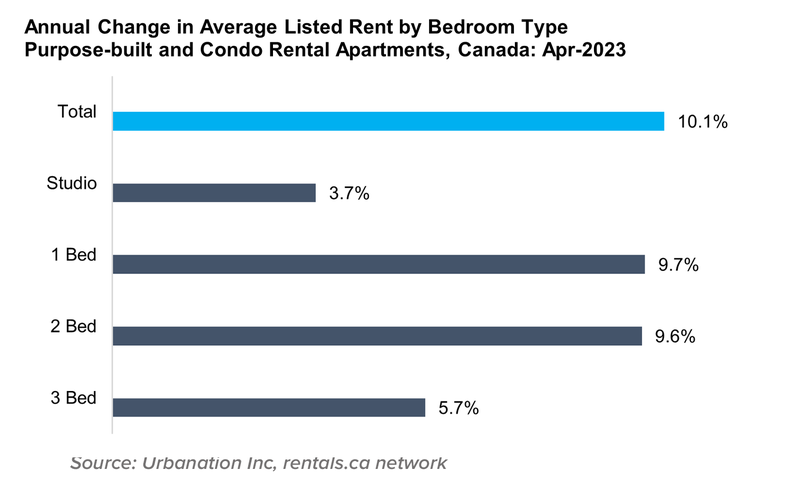
Provincial Overview

Ontario had the Fastest Annual Rent Growth in April
Annual rent inflation in April was strongest in Ontario, where average asking rents for purpose-built and condominium apartments increased 16.7% to $2,421. Alberta followed close behind with annual growth of 14.8% that pushed average rents up to $1,500 — a $921 discount compared to Ontario and a $968 discount compared to British Columbia ($2,468). Annual rent growth was slowest in British Columbia at 5.6%. In Quebec, rent inflation reached double-digits with 11% annual growth, with average rents reaching $1,850 in April. On a month-over-month basis, average rents increased the most in Alberta, up 2.7%.
Compared to the pandemic low in April 2021, rents have increased the most in Ontario (+29%) and B.C. (+28%).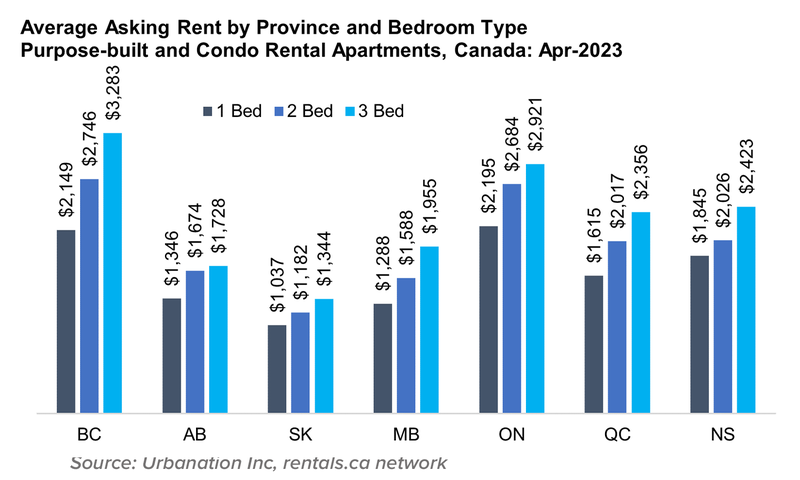
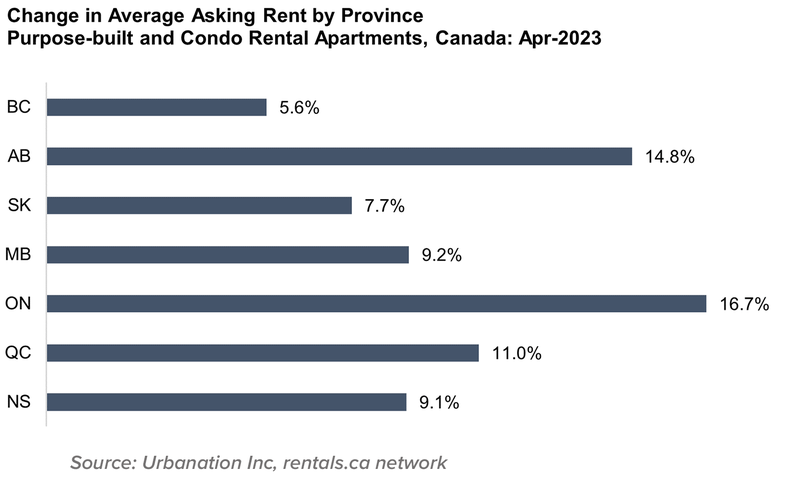
Municipal Rental Rates
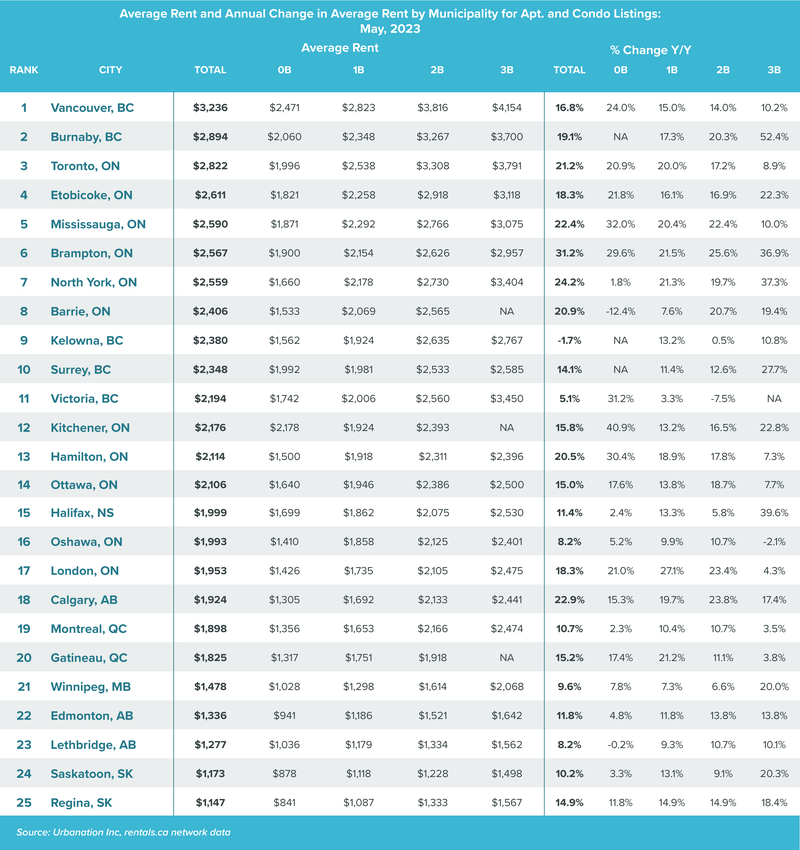
Vancouver and Toronto Rents Up More than 40% Since April 2021
The rankings for annual rent growth for purpose-built and condominium apartments among Canada’s largest markets were unchanged in April from the previous month. For the third consecutive month, asking rents increased fastest in Calgary, up 22.9% annually to $1,924. Toronto maintained its second place standing with annual rent growth of 21.2%, reaching an average of $2,822. Vancouver, the most expensive of Canada’s largest markets, recorded the third fastest annual rent growth of 16.8% in April, pushing average asking rents up to $3,236. Each of Canada’s six largest rental markets continued to see rents rise by more than 10% over the past year.
Compared to the pandemic low in April 2021, rents for condominium and purpose-built apartments have increased the most in Vancouver, up 47% and in Toronto, up 41%.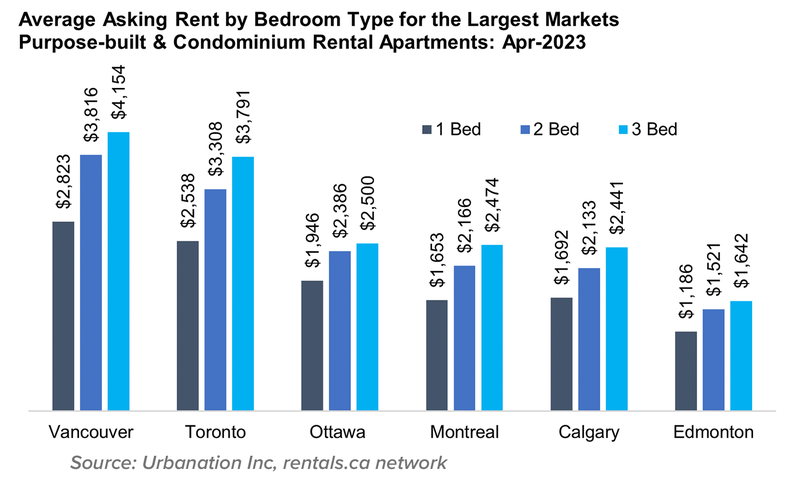
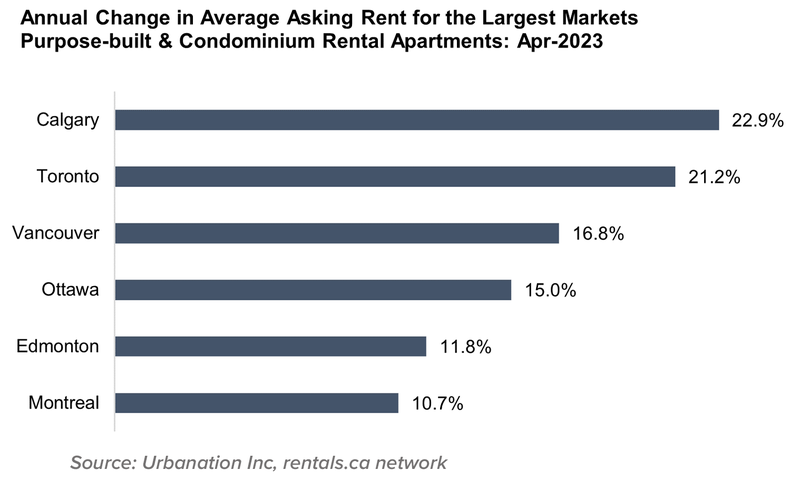
Mid-Sized GTA Markets Dominated Rent Growth in April
Among Canada’s mid-sized rental markets, Scarborough and Brampton continued to lead annual rent growth in April for condominium and purpose-built apartments with 31.9% and 31.2% increases, respectively. Markham, another hot spot for GTA immigration, moved into the third spot with annual growth of 30.3%. Average rents in these three markets were similar at $2,543 (Scarborough), $2,567 (Brampton), and $2,554 (Markham). Outside of the Greater Toronto Area, annual rent growth in medium-sized markets was led by Laval (+27%), Red Deer (+25.7%), and Coquitlam (+24.4%).
The highest rents among Canada’s mid-sized markets were in Oakville at an average of $3,413 for condominium and purpose-built apartments in April. The next three most expensive mid-sized markets were in British Columbia and included Burnaby ($2,894), Coquitlam ($2,788), and Richmond ($2,723). The next eight most expensive mid-sized markets were in the Greater Toronto Area. Outside the GTA in Ontario, the most expensive markets included Kanata ($2,411), Barrie ($2,406), Guelph ($2,336), Gloucester ($2,213), Cambridge ($2,197), Kitchener ($2,176) and Hamilton ($2,114)..
The only mid-sized market in the top 25 most expensive outside of Ontario and British Columbia was Halifax ($1,999).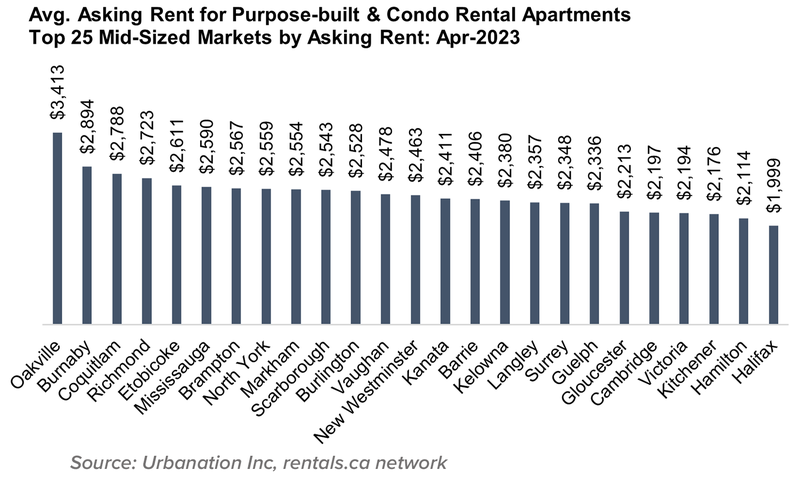
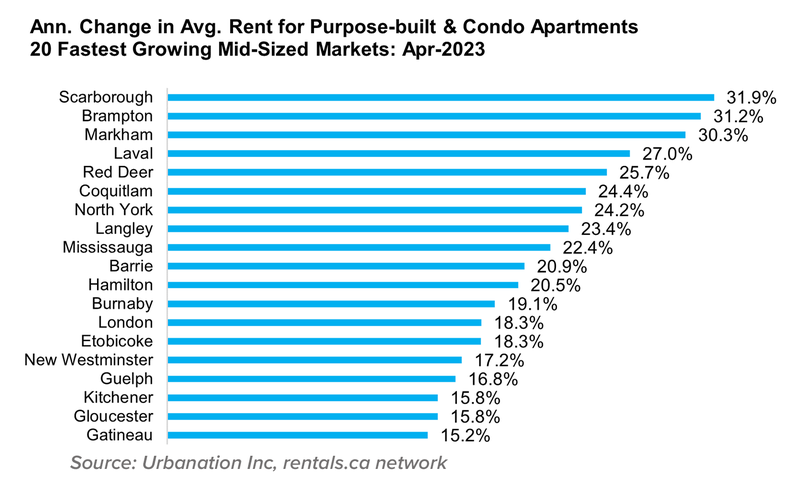
Rentals.ca Data
The data used in this analysis is based on monthly listings from the Rentals.ca Network of Internet Listings Services (ILS). This data differs from the numbers collected and published by the Canada Mortgage Housing Corporation (CMHC).
The Rentals.ca Network of ILS’s data covers both the primary and secondary rental markets and includes basement apartments, rental apartments, condominium apartments, townhouses, semi-detached houses, and single-detached houses. CMHC’s primary rental data only includes purpose-built rental apartments and rental townhouses. CMHC also collects data on secondary market rentals, but this is reported separately.
CMHC’s rental rates are based on the entire universe of purpose-built rental units (rental stock), regardless of rental tenure. CMHC rental rates are reflective of what the average household spends on rental housing and not the current market rents for vacant units. The data used in this report is based on the asking rates of available (vacant) units only and reflect on-going trends in the market. This covers a smaller sample size but is more representative of the actual market rent a prospective tenant would encounter. The Rentals.ca Network of ILS’s data typically provides much higher rental rates compared to CMHC, as vacant units typically reset to market rates when not subject to rent control.
The average and median rental rates in this report can also skew higher than CMHC’s data for the following reasons: the inclusion of larger more expensive unit types such as single-family homes, townhouse units, and large luxury condominium units; the presence of duplicate or multiple listings at the same property and the survivorship bias where more expensive or over-priced units take longer to lease and remain in the sample longer.
Properties listed for greater than $5,000 per month, and less than $500 per month are removed from the sample. Similarly, short-term rentals, single-room rentals, and furnished suites are removed from the sample when identifiable.













